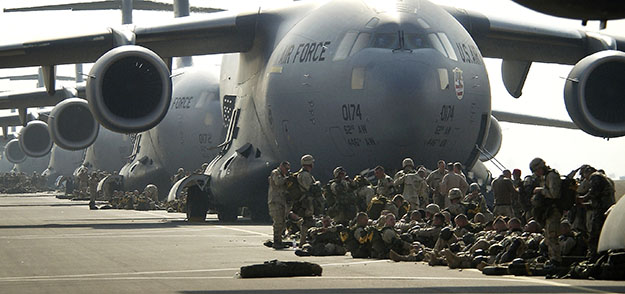When people think of mobility forces, lethality is not usually the first word that comes to mind. However, watching as 17 C-17 Globemaster IIIs carrying over a thousand Army paratroopers fly directly over you is a show of mobility forces.
This is the lethality of what C-17 crews do, they bring the thunder through the men and women, who are specially trained to fight and win.
This year marks the 20th anniversary of Operation NORTHERN DELAY, one of the opening salvos of Operation IRAQI FREEDOM. Early in 2003, U.S. Air Force Col. Robert R. Allardice, then 62d Airlift Wing commander, and planners from the 62d Operations Group and 62d Operations Support Squadron, planned the first ever low-altitude C-17 combat airdrop.
This airdrop became the largest troop drop since Operation JUST CAUSE in December 1989.
The mission was historic because many pilots had never flown in low-altitudes using night vision goggles and many of the U.S. Army paratroopers from the 173rd Airborne Brigade had never jumped from a C-17. Despite these challenges, they learned quickly as the goal was to take Bashur Airfield near Erbil and open a second front in Iraq after the initial invasion.
Staging took place at Charleston Air Force Base, South Carolina, and Rhein-Main Air Base, Germany, where mobility crews learned tactics and routes. Then it was on to Aviano Air Base, Italy, where loadmasters and C-17 jumpmasters instructed paratroopers how to exit the C-17 platform.
On the news, the world watched as Air Force F-117 stealth fighters attacked Saddam Hussein's Dora Farms complex near Baghdad on March 19, 2003, and watched combat operations unfold the next day.
For the C-17 crews and paratroopers, they must have felt the anticipation of their scheduled air assault and wondered if their forefathers felt the same thing during Operations OVERLORD during WWII and TOMAHAWK during the Korean War.
On March 26, 2003, everyone sprang into action as 17 C-17s lined the runway while crews, maintainers, and communications and weather personnel hustled to make ready the designated aircraft. Paratroopers stood by and checked their gear, waiting for their turn to board the Air Force's newest mobility aircraft. This was the moment they had trained and prepared for as soon they would jump into Iraq and secure an airfield critical to mission success.
All 17 Globemaster IIIs launched on time. Five C-17s carrying heavy equipment including High Mobility Multipurpose Wheeled Vehicles and weapons led the way followed by aircraft carrying personnel.
They did not fly alone as the Air Force and U.S. Navy sent F-14 Tomcats, F-18 Hornets, B-52 Stratofortresses, and E-3 Airborne Warning and Control Systems to protect the formation and ensure it arrived on target.
The formation flew into Iraq under the cloak of darkness. Pilots used NVGs to navigate the mountainous, low terrain through the poor weather and witnessed the sky light up with anti-aircraft artillery barrages yet despite this they pressed forward through enemy fire to the drop zone.
Now was the time as the formation plunged to a safe jump altitude and the lead C-17s opened their cargo doors and unloaded vehicles and weapons followed by the next ten aircraft that poured down a thousand Army paratroopers.
Rather than lead from the back, the most senior Army officer and enlisted paratrooper stood at the door first and hit the air when the jump light turned green. It was an impressive show of leadership that C-17 crew members carried with them throughout their careers.
With its cargo and jumpers out the door, the formation turned back towards Italy and refueled mid-air after an exhausting night of historic firsts. The mission was a success as paratroopers quickly took Bashur Airfield in short order.
Over the next few nights, C-17s performed air-land missions at Bashur Airfield to deliver additional service members and equipment. On April 16, the first humanitarian relief mission was completed and over the course of five nights, C-17 crews predominately from the 62d and 437th AWs flew 62 combat missions with 100% reliability and zero casualties.
These crews delivered 2,175 personnel, 3,060 tons of cargo, and 408 vehicles. Operation NORTHERN DELAY set a new standard in the history of airpower.
Today, the U.S. military frequently calls on the C-17 community to provide global airlift and the Army relies on C-17s as a platform for airborne operations. As NORTHERN DELAY demonstrated, the C-17 maintains the ability to airlift a plane load of trouble anywhere in the world.
Twenty years have passed since the execution of NORTHERN DELAY, but the 62d Airlift Wing is always ready to bring the fight. Any place. Any time.





Read Comments